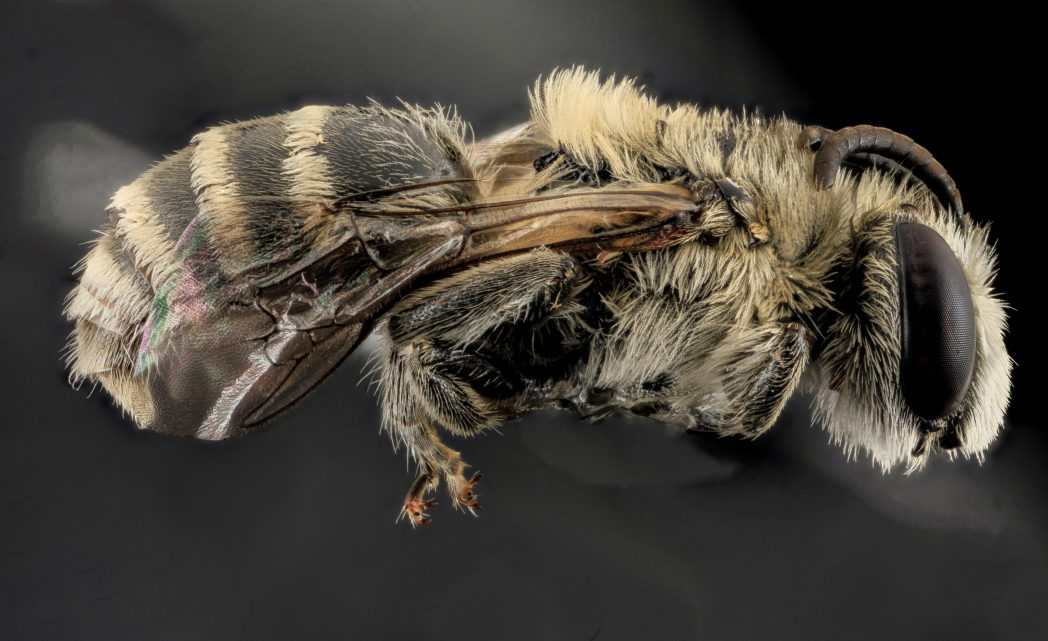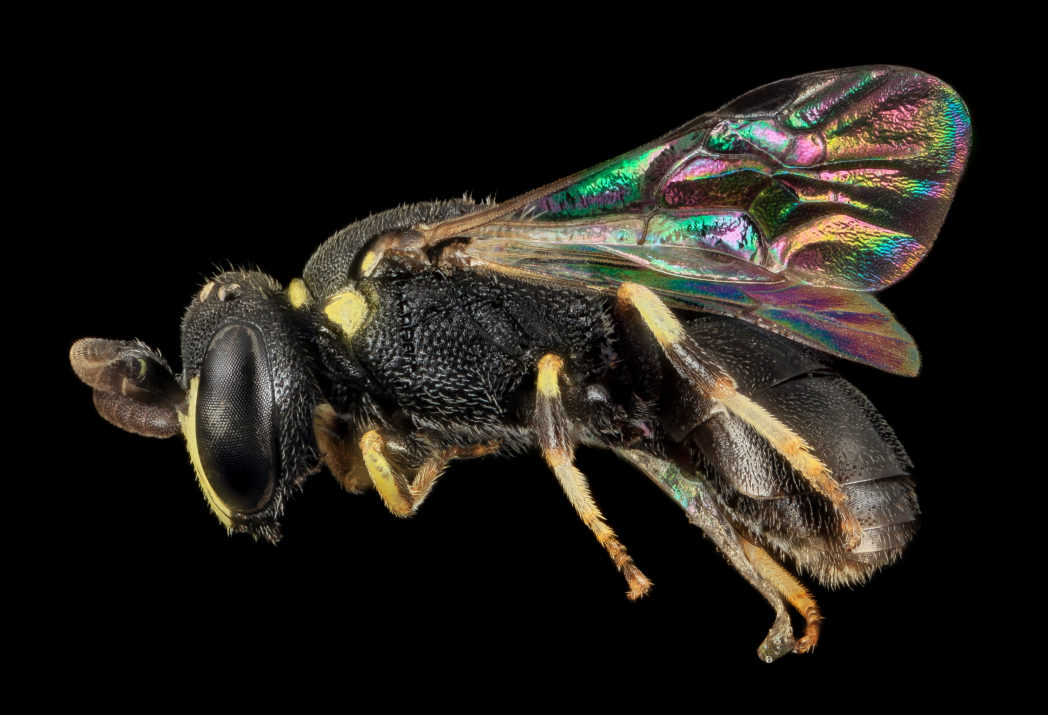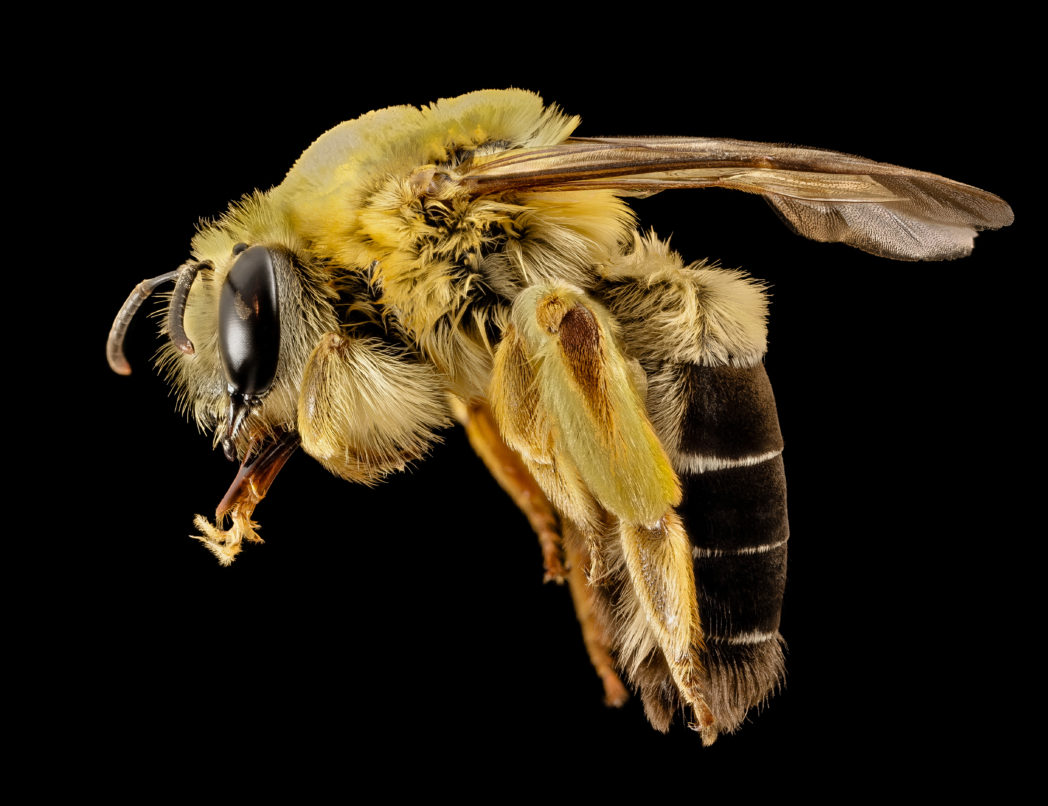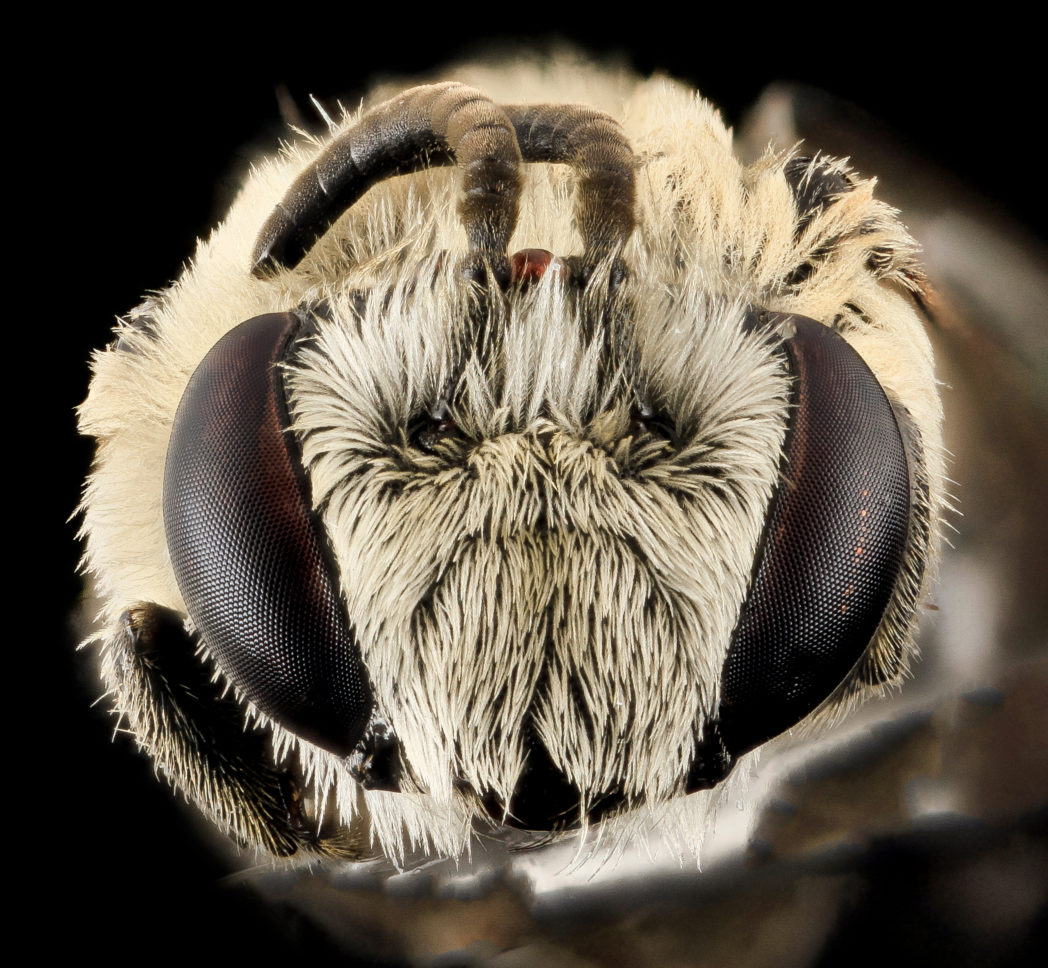Polyester bees
by Jonnie Dietz, Florida Museum of Natural History
“Know your native pollinators” is a series of articles that will help you identify and appreciate Florida’s varied pollinators, including bees, wasps, butterflies, moths, beetles, flies, birds and bats. Pictured above: Colletes titusensis. Photo courtesy of USGS Native Bee Inventory and Monitoring Laboratory.
Colletids are one of the smaller bee families in Florida, but are diverse in size and appearance. They’re named for the unique cellophane-like substance that many females secrete to line the walls of their nest cells.
CLASSIFICATION
Class: Insecta
Order: Hymenoptera
Family: Colletidae
FORAGING PREFERENCES
Bees in the Colletidae family are short-tongued, so they typically gather nectar from shallow flowers such as those in the Asteraceae (daisy or aster), Apiaceae (carrot or parsley), and Fabaceae (pea or legume) family. While many are generalists, some are specialists and only forage from one family or genus of plants.
Other plants on which Colletidae have been spotted foraging:
- Eastern redbud (Cercis canadensis)
- Yaupon holly (Ilex vomitoria)
- Florida swamp privet (Forestiera segregata)
- Camphorweed (Heterotheca subaxillaris)
- Baccharises (Baccharis spp.)
- Pepperweed (Lepidium spp.)
- Goldenrod (Solidago spp.)
- Fleabane (Erigeron spp.)
IDENTIFICATION
This family gets its common name, polyester bees (or plasterer bees), from the cellophane- or silk-like substance that they secrete. Using their tongues, females coat this substance on the walls of their nest cells. Not only is it waterproof, but it protects against potential contaminants such as fungi.
Florida is home to three genera of Colletidae — Colletes, Hylaeus and Caupolicana — and five endemic species. Each genus is distinctly different and easy to distinguish, but individual species can be difficult to identify, even at the microscopic level. Most are slender with triangular or heart-shaped faces, and short tongues (glossa) that are split at the tip.

Colletes titusensis. Photo courtesy of USGS Native Bee Inventory and Monitoring Laboratory.
Colletes (subfamily Colletinae)
Number of Florida species: 15
Number of endemic species: 2 (Colletes titusensis and C. longifacies)
Colletes are small to medium in size (0.3 to 0.6 inches long) and quite hairy in comparison to similar sized bees. Many have pale bands of light colored hair on their abdomen and eyes angled outward, creating the appearance of a heart shaped face.
Most Colletes are active in either spring or fall, but usually not during summer. They forage on a variety of flowering shrubs and trees, preferring woody species over herbaceous.
NESTING
Colletes usually construct their nests in open areas with little vegetation, and some species nest in great aggregations. Females collect pollen, water and nectar as provision for each egg, and deposit it in the nest cell as a syrupy mass (rather than a hard pollen ball like most bees). Eggs are deposited on the cell wall near the goopy provision.

Hylaeus floridanus. Photo courtesy of USGS Native Bee Inventory and Monitoring Laboratory.
Hylaeus (subfamily Hylaeniae)
Number of Florida species: 10
Number of endemic species: 3 (Hylaeus graenicheri, H. flammipes, and H. volusiensis)
Unique among the bees, Hylaeus are small (about 0.2 to 0.3 inches), nearly hairless and often confused for wasps. They are mostly black with white or yellow markings on their face, thorax and legs. As such, they are also known as yellow-faced or yellow-masked bees. Females lack the scopa, or pollen-collecting hairs, characteristic of most female bees. Instead, they eat pollen and nectar and carry it back to their nest in a “honey stomach” where it’s regurgitated as provisions for their eggs.
Hylaeus mainly fly in spring, however some species may emerge in late summer or early fall. Although they have short tongues, their small size allows them to access nectar from larger flowers.
NESTING
Females construct their nests in premade holes (e.g. hollow stems, nail holes, natural holes in rock) and line the cells with a cellophane-like substance similar to that of the Colletes. Hylaeus are found in a wide variety of Florida habitats, including sandhill sites, wetlands, and wet flatwoods.

Caupolicana electa. Photo courtesy of USGS Native Bee Inventory and Monitoring Laboratory.
Caupolicana (subfamily Diphaglossinae Vachal)
Number of Florida species: 1 (Caupolicana electa Cresson – considered locally extinct)
Fast flying and relatively large (about 1 inch long), these bees are crepuscular, flying at twilight and just before dawn, rather than during the day. They have a strong preference for flowers in the Fabaceae (pea or legume) and Lamiaceae (mint) family, but are often observed nectar-robbing even before flowers have fully opened.
Only one species, Caupolicana electa Cresson, has been documented in Florida’s Miami Dade County. Although this population is now considered extinct, this Caupolicana species still occurs in sandhill regions of other southeastern states.
References:
- The Bees of Florida. John B. Pascarella, Ph.D., Dean of the College of Sciences, Professor of Biological Sciences, Sam Houston State University, Huntsville, Texas. http://entnemdept.ufl.edu/HallG/Melitto/Intro.htm
- Michener, Charles D. The Bees of the World. Baltimore: Johns Hopkins U Press, 2010. Print.
- “Florida’s Native Bees.” Jaime Pawelek. http://www.floridasnativebees.com
- Mitchell, Theodore B. Bees of the Eastern United States, Volume 2. Raleigh, NC: Published by the North Carolina Agricultural Experiment Station with Support from the National Science Foundation, 1962. Print.
- Wilson, Joseph S., and Olivia Messinger Carril. The bees in your backyard: a guide to North America’s bees. Princeton: Princeton U Press, 2016. Print.
- The Xerces Society. Attracting Native Pollinators: The Xerces Society Guide to Conserving North American Bees and Butterflies and Their Habitat. North Adams, MA: Storey Pub., 2011. Print.

